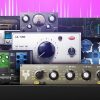-
 play_arrow
play_arrow
Clubalicious Clubalicious Radio
-
 play_arrow
play_arrow
London Calling Podcast Yana Bolder

Looking back, the June 2021 launch of Apple Music’s Spatial Audio service was a major milestone. Dolby Atmos had long since become commonplace in the cinema, starting with Disney/Pixar’s Brave in 2012. Five years later, Netflix rolled out its Dolby Atmos support and set off an explosion of new and upgraded immersive mix rooms worldwide. However, Spatial Audio was a proverbial pivot point, supported and encouraged by the major record labels and various pro-audio manufacturers. Within a year of the launch, more than three-quarters of Apple Music subscribers were reportedly listening to immersive music.
Sound engineering and music schools teaching audio technology, dedicated to educating students in current and cutting-edge workflows, have responded. Just this year, a handful of educational institutions have launched new Dolby Atmos music mixing facilities, the better to ready students for jobs in today’s entertainment media industry. The following are just some of the latest to open.
Line Studio at WMS
Eight years ago, Washington Middle School audio educator Sam Fong and principal Michael Harano launched Line Studio at WMS, an ambitious project to bring opportunities to under-privileged young people and local aspiring musicians in Hawaii who have very few opportunities to work in a professional-grade production studio. Backed by the Hawaii State Department of Education, the 1,600-square-foot facility at the Title-1 public school in Honolulu on the island of O’ahu was unveiled in mid-2024 and will officially open in 2025.
The Walters-Storyk (WSDG) design team handled studio design, acoustic design and isolation, technical interior design and systems design for the facility, which has been named Line Studio at WMS. All A/V components were provided and installed onsite by Boston, Mass.-based AVN | SYS.
“We truly want to elevate the quality of life for our students and present them with opportunities that broaden their own vision of what their lives can become,” says Fong, the facility’s sound recording studio director. “Contextualized learning is a big deal for us, so it has to be relevant to young people’s lives and the dreams they will be pursuing.”
On the one hand, he says, “With students, we could offer them a real opportunity to develop their minds and skillsets when it comes to audio and music that would be applicable whether they choose to work here or on the mainland. We also knew that by opening the studio up to public projects, we could enrich the culture for local musicians by providing opportunities that might not have existed before for them also in terms of recording and production.”
The room, at Fong’s insistence, is outfitted with equipment that would make any high-end New York or L.A. studio envious: an SSL AWS 948 analog mixing console, custom Symphonic Acoustics speaker system, jointly designed by WSDG and George Augspurger, and an ATC 7.1.4 speaker array for immersive production and mixing, enabled by an Avid MTRX and a NewTek Tricaster. The outboard racks are stocked with devices from Bricasti, Empirical Labs, Teletronix, Tube-Tech, UA, API, Avalon and others.
While the space is a professional recording studio, it also has to function as a classroom. Advanced predictive analysis was provided by REDIacoustics NIRO software to aid in the layout design of the space while providing an optimized acoustic environment in each of the facility’s rooms. Those spaces were created with room-in-room construction to aid in acoustic isolation. The facility also has multiple ISO booths, a sizable equipment storage closet, and a sound lock with wheelchair access Honoring the island environment, WSDG echoed the local karo plant’s trunk and leaves in the tracking room’s rear-wall wave diffuser and other acoustic treatments. Local materials were heavily favored in the construction process.
Written by: Admin
Similar posts
Recent Comments
No comments to show.Featured post

Latest posts
Current show
Upcoming shows

In Session
Sister Bliss
16:00 - 17:00
Finnish Dance Chart
Top 40 Hottest Dance Tracks In Finland
17:00 - 19:00
Made To Move
Jacob Colon
19:00 - 20:00
In Session
Sister Bliss
20:00 - 21:00
Fresh Is Fresh
This Weeks Hottest Releases
21:00 - 00:00Chart
Powered by Dee jay promotions visit us













 Invalid license, for more info click here
Invalid license, for more info click here